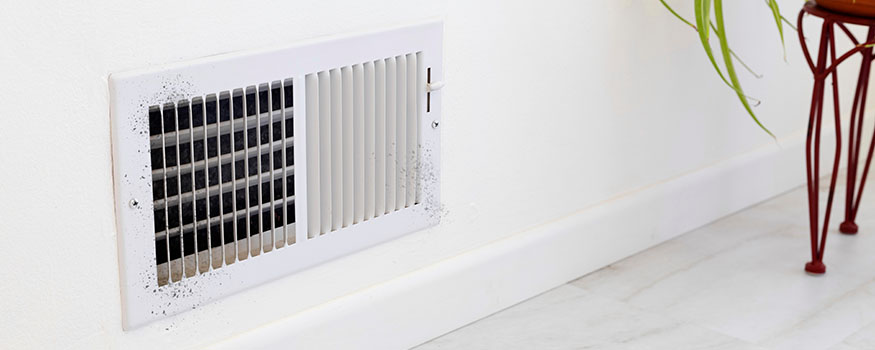If you’ve ever noticed a musty odor when your AC kicks on, you’re not imagining it. That damp, earthy scent often points to mold inside the HVAC system—clinging to vent covers, lining ducts, or growing in the condensate pan where moisture collects. Because your system circulates air through the entire home, spores can spread quickly, but minor cases are manageable with proper steps and a focus on moisture control.
What Causes Mold in Air Vents?
Mold needs three things to thrive: moisture, organic material (even dust counts), and time. Dust in ducts—made up of skin cells, fibers, and pollen—provides enough “food.” Moisture appears when warm, humid air meets chilled metal in vents or ducts, creating condensation. Common trouble spots include supply vents and the first few feet of duct behind them, evaporator coils, and drain pans. Poor insulation or clogged drain lines allow moisture to linger and give mold a foothold.
Signs to Watch For
Look (and smell) for these warning signs:
- A musty, earthy odor when the blower starts
- Patchy black, green, or gray growth around registers
- Dust that feels slimy or looks fuzzy when wiped
- Recurring rings or smudges near vents that return after cleaning
Not all dark marks are mold—soot or regular dust can be misleading—but if the mark smells damp or comes back quickly, treat it as mold. Even non-allergic household members can experience irritated airways from airborne fragments.
Safe DIY Air Vent Mold Removal
If growth is limited to the register and the first foot of metal duct, you can often handle it yourself—safely and effectively. Follow these steps:
- Turn the system off at the thermostat to avoid circulating spores.
- Remove the register cover and wash in warm, soapy water. Disinfect with 70% isopropyl alcohol or hydrogen peroxide, then dry completely.
- Use a HEPA-filter vacuum to gently clean the duct opening and surrounding wall area—only the first foot or so.
- Lightly mist a cloth with hydrogen peroxide or an HVAC-safe mold cleaner and wipe reachable metal surfaces. Avoid soaking insulation or spraying into the duct.
- Replace the air filter with a fresh MERV 8–11 (verify compatibility with your system).
- Clear the condensate drain line by pouring a cup of white vinegar into the access tee, and confirm the outdoor drain is flowing. A wet/dry vac on the exterior line can help if it’s clogged.
Avoid bleach: it can corrode metal, doesn’t penetrate porous dust effectively, and creates hazardous fumes.
When to Call a Professional
Call a qualified HVAC technician or a NADCA-certified duct cleaning company when:
- The musty smell spreads through multiple rooms
- Growth is visible beyond the register area or inside flex/ductboard
- The problem returns quickly after DIY cleaning
- Duct materials are porous (fiberglass, ductboard) or insulated internally
- Someone in the home has asthma, severe allergies, or a weakened immune system
Professionals use negative-pressure containment, HEPA vacuums, and agitation tools. They’ll inspect coils, blowers, drain pans, and ducts, sanitize metal surfaces with EPA-approved products when appropriate, clear and level drain pans, and recommend sealing or replacing moldy duct sections. Don’t be swayed by very low bids or chemical-only “fogging” without thorough cleaning—effective service focuses on removing contaminants and correcting moisture sources.
Prevention: the Most Important Step
Moisture control and regular maintenance are the best defenses:
- Keep indoor humidity around 40–50% with dehumidifiers or whole-home systems if needed.
- Insulate ducts in attics and crawlspaces to stop condensation on cold metal surfaces.
- Change filters every 1–3 months depending on pets and dust levels.
- Set the HVAC fan to “Auto” so the coil can drain between cycles instead of staying damp with constant airflow.
- Schedule preventive HVAC service (coil and drain cleaning) at least annually.
- Use exhaust fans in bathrooms and kitchens, and repair leaks promptly.
- For crawlspaces, consider proper vapor barriers, ventilation, or encapsulation to reduce overall moisture.
Why Professional Maintenance Matters
Mold typically indicates an underlying moisture issue. A professional inspection can identify and correct problems such as a clogged drain, leaking duct connections, or missing insulation. During routine service, technicians clean and dry the evaporator coil, flush the condensate line, measure humidity and static pressure, and seal leaks—actions that reduce mold risk and improve system efficiency and longevity.
The Bottom Line
A musty smell or tiny black specks at a vent should never be ignored. Start with careful cleaning and moisture checks, then call a certified HVAC professional if the issue is widespread or recurring. With proper cleaning, drainage, and ongoing maintenance, you can keep your home’s air fresh and mold-free.

